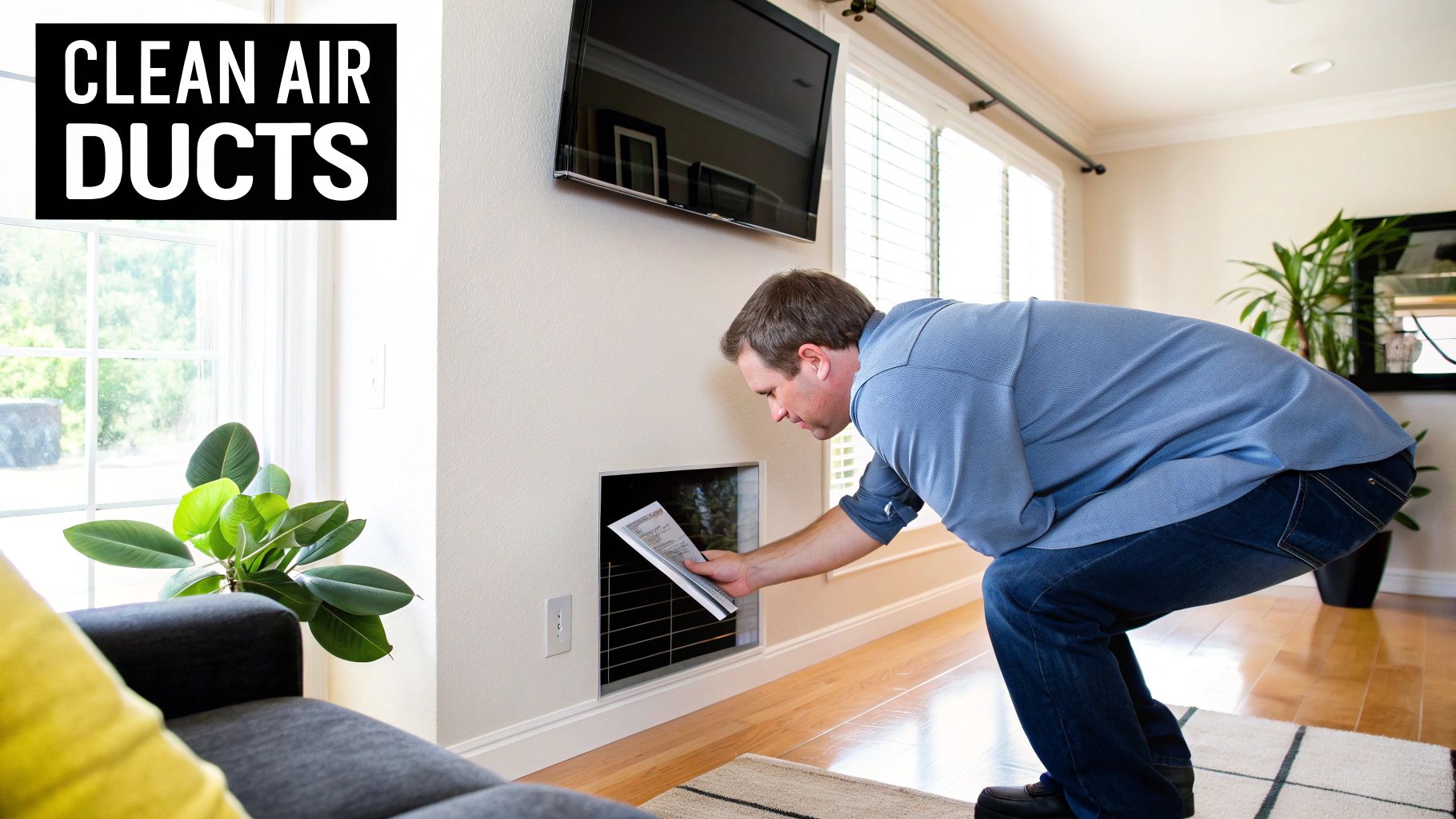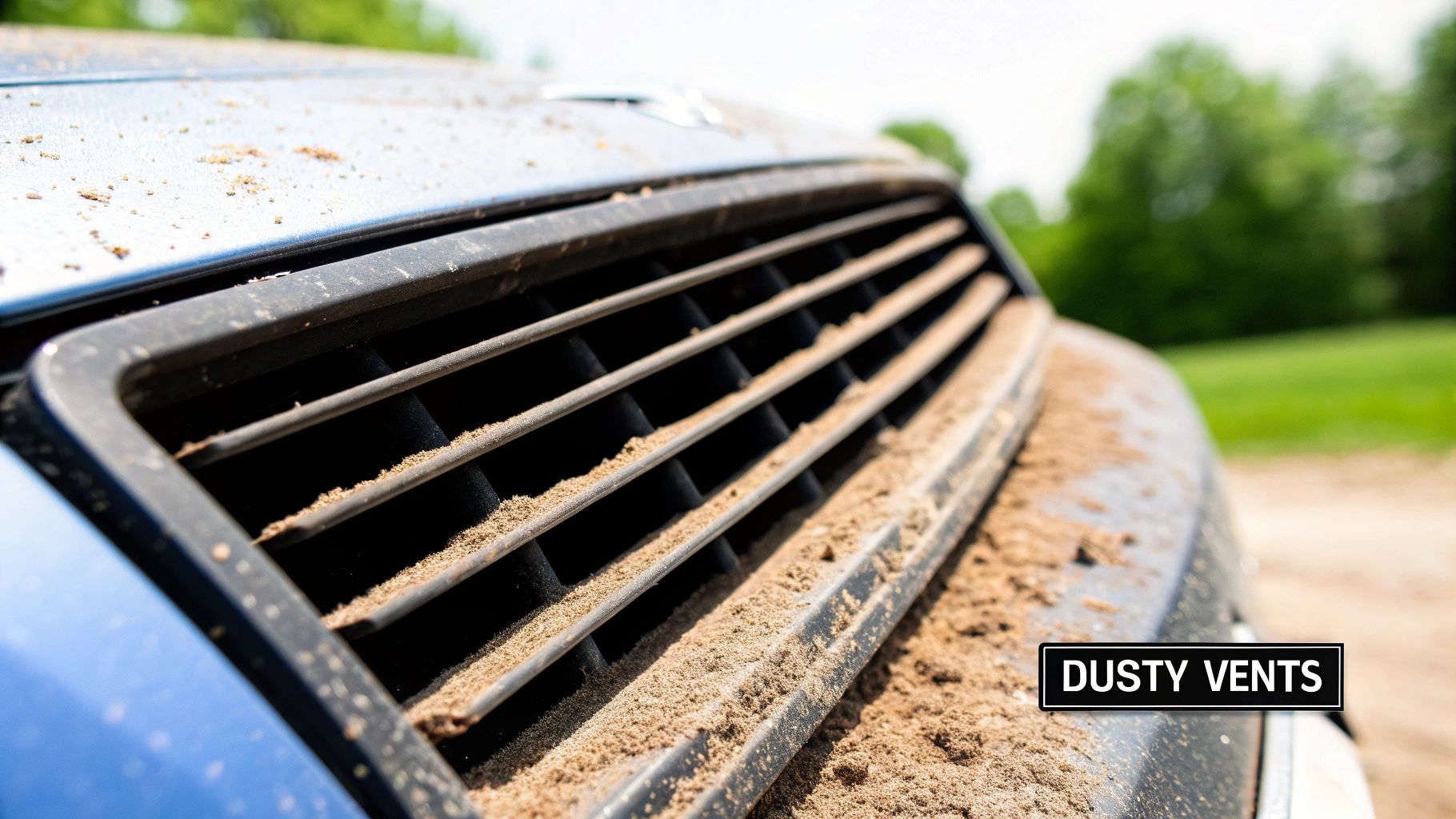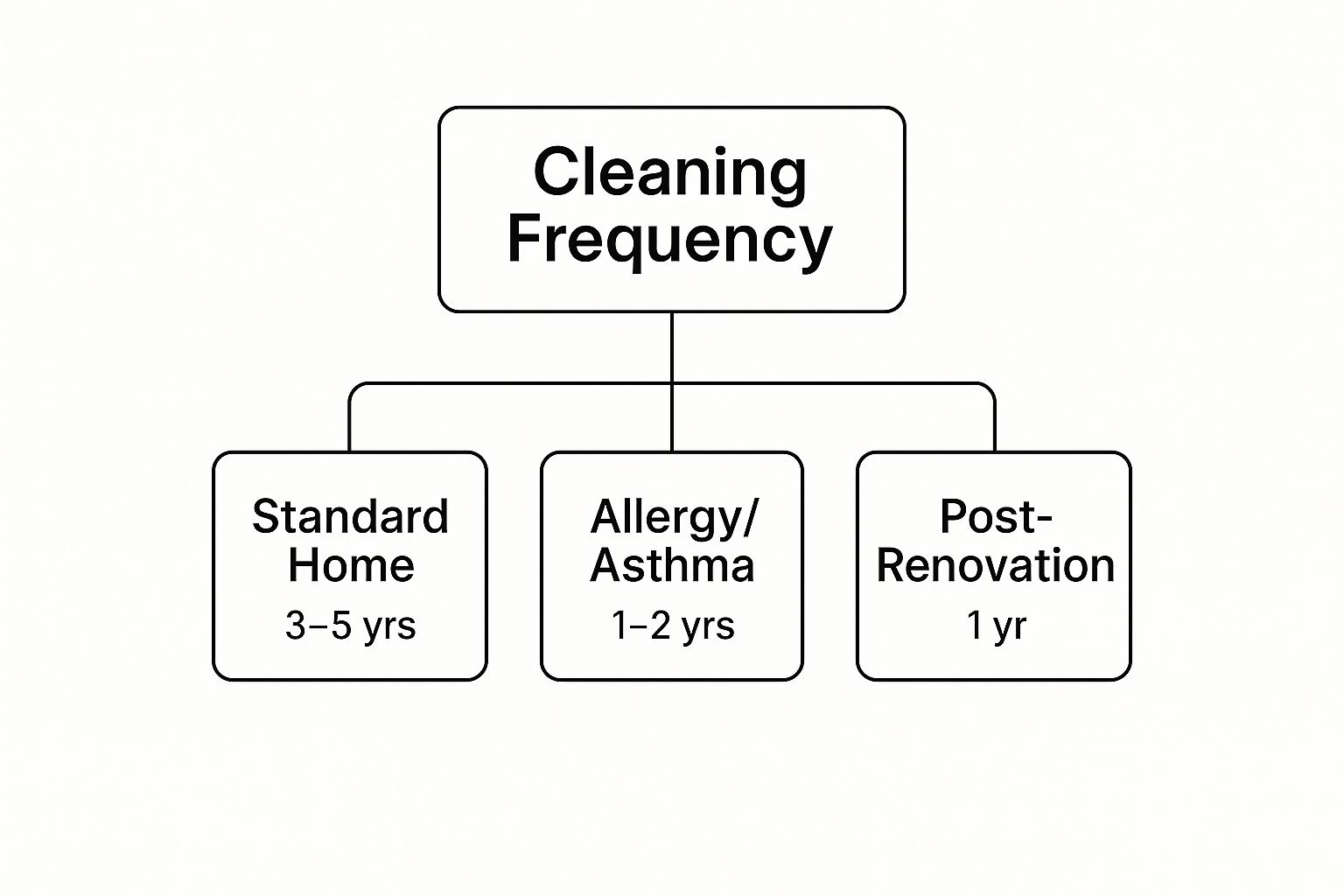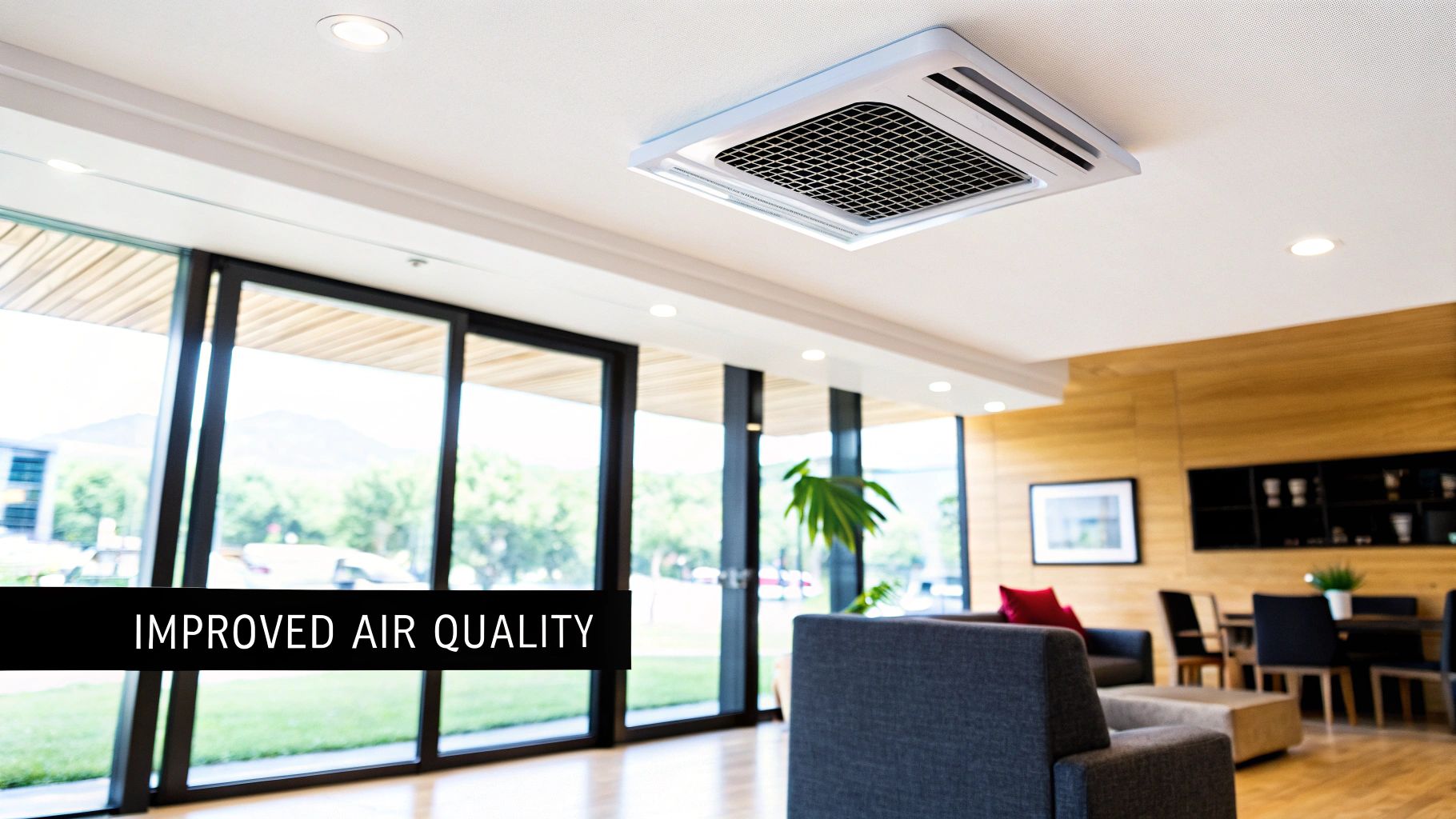So, how often should you really be cleaning your air ducts? The industry standard is a pretty broad range: every 3 to 5 years.
But let's be honest, that's just a starting point. It's a useful rule of thumb, but it doesn't tell the whole story. Your home isn't "standard"—it's unique, and your lifestyle plays the biggest role in figuring out the right schedule for you.
Your Air Duct Cleaning Schedule Explained

Think of it this way: you wouldn't use the same oil change schedule for a car that sits in the garage as you would for one that's driven through a dusty desert every day. The same logic applies to your home's ductwork. The right cleaning frequency is less about the calendar and more about what's happening inside your four walls.
Certain situations can definitely put your HVAC system on the fast track for a cleaning. If any of these sound familiar, you’ll likely need to shorten that 3-to-5-year window:
- You Have Pets: We love our furry friends, but their dander, hair, and tracked-in dirt quickly build up inside your ducts and get circulated every time the system kicks on.
- Allergies or Asthma Run in the Family: Your ductwork can become a reservoir for dust mites, pollen, and other irritants. More frequent cleaning is a game-changer for improving indoor air quality.
- You've Just Renovated: That fine layer of construction dust gets everywhere, including deep inside your vents. A post-renovation clean is non-negotiable.
Ultimately, effective residential duct cleaning is all about tailoring the service to what your home actually needs, not just blindly following a generic guideline.
Staying on top of duct cleaning isn't just about breathing fresher air. It also helps your entire HVAC system run more smoothly, which can lead to lower energy bills and a longer lifespan for your equipment.
Air Duct Cleaning Frequency At a Glance
To make things a bit clearer, we've put together a simple chart. Think of it as a quick reference guide to help you pinpoint a cleaning schedule that makes sense for your household.
| Household Condition | Recommended Cleaning Frequency |
|---|---|
| Standard Home (No pets, no allergies) | Every 3 to 5 years |
| Home with Pets | Every 2 to 3 years |
| Allergy or Asthma Sufferers | Every 2 to 3 years |
| After Major Home Renovations | Immediately after completion |
Use this table to find the best starting point for your home, and remember to adjust based on your own observations. If your allergies are acting up or you see dust accumulating faster than usual, it might be time for a clean.
Why the 3 to 5 Year Rule Is Just a Starting Point

To really get a handle on how often you should clean your ducts, it helps to picture what's going on inside them. Think of your HVAC system as your home's lungs, and the ducts are the airways, carrying fresh air to every single room.
It's completely normal for a little bit of dust, dander, and other airborne gunk to settle in these passages over time. For the first couple of years, this buildup is usually so minor that it doesn't cause any real issues.
But eventually, that accumulation starts to choke off airflow, much like a clogged artery. Your HVAC system has to work harder, and the air circulating through your home just isn't as clean. This is where that common recommendation comes from.
Where Does That Number Come From?
That 3 to 5 year window isn't just pulled out of thin air. It's the timeframe that experts, including the National Air Duct Cleaners Association (NADCA) and top Canadian service providers, have identified for the average home to collect enough debris to negatively affect efficiency and air quality.
This baseline assumes a "typical" household – maybe a few people, no pets, no smokers, and no one with serious allergies or asthma. It’s a great starting point for most homeowners, but it’s crucial to remember that it's just that: a starting point.
Think of the 3 to 5 year rule as the factory default setting. It works for a lot of people, but it doesn't account for the unique conditions of your home. The real answer to "how often?" involves tweaking that setting based on your lifestyle.
The factors specific to your home are what truly dictate the right cleaning schedule. For instance, a house with two dogs that shed constantly and a family member with asthma will need a much different plan than the "average" home. Shifting from a generic timeline to a personalized one is better for your family's health and ensures you're investing in the service when it will have the most impact.
If you're wondering what the actual service entails, you can learn more about how long professional air duct cleaning takes in our detailed guide.
When to Clean Your Ducts More Often Than Every 3-5 Years
While the 3-to-5-year rule is a great starting point, it’s not a one-size-fits-all solution. Think of it as a baseline. Certain things happening in your home can seriously speed up how quickly dust, dander, and other gunk builds up in your ductwork.
Every home is different, and if any of the situations below sound familiar, you'll want to think about getting your ducts cleaned more often—probably closer to every two or three years.
Life Events That Call for a Shorter Cleaning Cycle
It’s often the day-to-day living—especially with furry friends or family members with sensitive lungs—that makes the biggest difference.
- You Have Pets: We love our pets, but they’re little machines for producing dander, fur, and tracking in dirt from outside. All of that gets sucked straight into your HVAC system, circulating allergens and clogging things up much faster.
- Someone in the House Has Allergies or Asthma: If you or a family member struggles with respiratory issues, your air ducts can become a hidden reservoir of triggers. Dust mites, mould spores, and pollen can all settle in there, just waiting to be blown back into your rooms. Frequent cleaning helps get rid of these irritants right at the source.
- There Are Smokers in the Home: The sticky, smelly residue from tobacco smoke doesn't just cling to walls; it coats the inside of your ductwork. This coating acts like a magnet for other dust and debris, creating lingering odours that your HVAC system circulates endlessly.
This is a great visual of how these factors can change your cleaning timeline.

As you can see, homes with renovations or with people sensitive to air quality need a much more aggressive cleaning schedule.
The Big One: Renovations and New Construction
Outside of daily life, construction is probably the single biggest event that should have you calling a duct cleaning company.
Moving into a brand-new house or finishing up a major renovation are two times you absolutely should schedule a duct cleaning. All that fine drywall dust, sawdust, and other construction debris doesn’t just disappear—it settles deep inside your ventilation system.
This isn't just a light dusting. It’s a thick layer of fine particles that can choke your airflow and put a serious strain on your HVAC unit right from the start. If you skip a post-renovation cleaning, you’re basically signing up to breathe in leftover construction mess for years to come.
By paying attention to these triggers, you can create a cleaning schedule that actually makes sense for your home and your family. To get a better idea of what's involved, check out our complete guide to professional air ventilation cleaning.
How to Spot the Warning Signs of Dirty Ducts

While the calendar can give you a general idea of when to schedule a cleaning, your home often drops much more immediate hints. The best tools for the job are often your own senses—you just need to know what you’re looking, smelling, and listening for.
Think of your HVAC system like your home’s respiratory system; it will definitely show symptoms when it’s not feeling its best. Spotting these signs early means you can tackle the problem before dust, allergens, and other gunk really take hold.
One of the most in-your-face signs is seeing visible dust puffing out of your vents the moment your furnace or AC kicks on. You might also notice that you have to dust your furniture far more often than you used to, with a new layer settling just a day or two after cleaning.
Signs You Can't Ignore
Beyond what you can see, there are other clues that your ductwork is clogged and crying out for help. Keep a close eye (and nose) out for any of these issues popping up:
- Persistent Musty Odours: If a stale or mouldy smell wafts from your vents when the system is running, that’s a major red flag. It often means mould or mildew has started growing in the dark, damp environment inside your ductwork.
- Uneven Airflow: Do some rooms feel stuffy and warm while others are chilly? Clogs from dust and debris can create roadblocks in the ducts, preventing air from flowing properly and leading to inconsistent temperatures around the house.
- Unexplained Allergy Flare-Ups: Is your family suddenly sneezing, coughing, or dealing with watery eyes more than usual indoors? Your ducts could be circulating a heavy dose of irritants like dust mites, pollen, and pet dander throughout your home.
Another tell-tale sign that’s easy to miss? An unexpected spike in your energy bills. When ducts are clogged, your HVAC system has to work much harder to force air through the blockages. That extra effort means a serious dip in efficiency and a noticeable jump in your monthly utility costs.
The True Value of Keeping Your Air Ducts Clean
Getting your air ducts cleaned isn't just another item on the home maintenance checklist—it's a real investment in your family’s health and the efficiency of your HVAC system. Think about what's hiding in there: a cocktail of dust mites, pet dander, and even mould spores. Every time the heat or AC kicks on, that stuff gets blasted right back into the air you breathe.
Clearing out all that gunk makes a world of difference, especially for anyone in the house with allergies or asthma. It’s about creating a genuinely healthier living space.
Now, picture your HVAC system trying to push air through ducts choked with debris. It’s like trying to run a marathon while breathing through a straw. The system has to work way harder, which not only spikes your energy bills but also puts a massive strain on its most critical parts. That kind of stress can lead to expensive breakdowns much sooner than you'd expect.
Boost Efficiency and Protect Your Investment
Being proactive about duct cleaning is simply a smart financial move. When the airways are clear, your HVAC system doesn't have to fight to do its job, which often translates to lower hydro bills. More importantly, you're extending the lifespan of one of your home's most expensive appliances.
Committing to a regular cleaning schedule prevents minor issues like dust accumulation from turning into major system malfunctions. This simple step is one of the most effective ways to protect your significant home comfort investment.
Sticking to a schedule and hiring a reputable company helps Canadians keep their air clean and their systems running smoothly. It prevents blockages, reduces energy waste, and helps you sidestep those dreaded repair calls. Ultimately, this proactive approach saves you a lot of money and hassle down the road. To get a better idea of what to budget, you can explore a detailed breakdown of the average cost of duct cleaning. You can also learn more about how maintenance impacts your HVAC system by checking out the insights from industry experts like AirTech AC.
Common Questions About Air Duct Cleaning
Even when you know why and when to get your ducts cleaned, a few questions about the actual process might pop up. Let's clear the air on some of the most common ones so you know exactly what to expect.
Can I Just Clean My Air Ducts Myself?
It's tempting to think you can tackle this job with a vacuum cleaner, and while cleaning your vent covers is a great maintenance step, it barely scratches the surface. The real gunk—dust, dander, and debris—is hiding deep inside the ductwork, far beyond the reach of any household tool.
Professionals bring in the heavy-duty equipment, like truck-mounted vacuums and specialized agitators, to loosen and suck out years of buildup safely. Trying a deep clean yourself usually just stirs everything up, pushing contaminants deeper into the system or, even worse, blowing them straight into your living space.
Think of it like this: You can sweep the entrance to a long tunnel, but you need specialized equipment to clean it from end to end. Professional duct cleaning ensures the entire network is cleared, not just the parts you can see.
How Long Does a Professional Cleaning Take?
For most average-sized homes in the GTA, a complete and thorough duct cleaning will take somewhere between three to five hours. Of course, this isn't set in stone.
The final time depends on a few things:
- The size of your home.
- How complex or easy it is to access your ductwork.
- How much dirt and grime has built up inside the system over the years.
Any reputable company will give you a solid time estimate after they've had a chance to look at your system, letting you plan your day without any surprises.
Will Duct Cleaning Actually Improve My Health?
For a lot of households, especially those with allergy or asthma sufferers, the answer is a resounding yes. Your ducts can act like a hidden storage unit for allergens—think dust mites, pet dander, pollen, and even mould spores. When your HVAC system kicks on, it circulates these irritants all over your home.
By physically removing them from the source, you stop that cycle. It’s not a magic cure, but it dramatically reduces the triggers floating around in the air you breathe every day, creating a healthier, more comfortable home. If you want to dive deeper into how it all works, you can check out our detailed guide on professional ventilation ducts cleaning.
At Can Do Duct Cleaning, our trained technicians conduct a full on-site inspection to determine the safest and most effective approach for your home. Book your professional duct cleaning service with us today!


